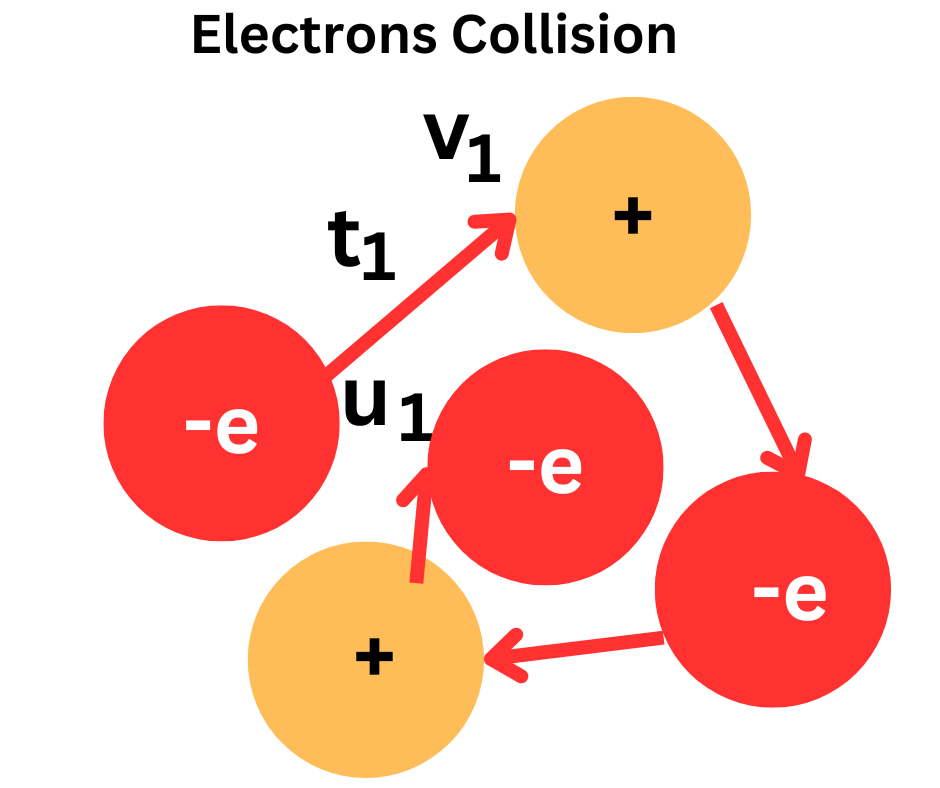The drift velocity is zero when no external field is applied to the conductor. The electrons move slowly on the application of an electric field around the conductor. This slow movement of electrons is called the drift velocity.
Here, we will first understand why electrons move slowly when an external electric field is applied around the conductor. The electrons tend to move faster, but in their path, they face hindrances. When an electron is released from the atom, the ion of the atom causes retardation in the velocity of the electron. Also, the collision between the released electrons retards their velocity. The retardation in the velocity causes electrons to move randomly rather than in a straight line.
An electron travels a considerable distance due to this collision phenomenon, and we can say the average speed of electrons is very high, but the collision retards the velocity of electrons, and again electrons accelerate and regain their velocity. This process limits the velocity of electrons; thus, electrons move slowly rather than swiftly.
Drift Velocity Definition
The meaning of drift is to move slowly. The electrons move slowly towards the positive potential when an external electric field is applied around the conductor. Thus, the average velocity of electrons is called the drift velocity. The electrons move in an axial direction of the plane.
The drift velocity can be defined as the average velocity of the electrons drifting from the conductor to a positive supply of the external electric field.
Net Velocity of the Electrons:
When no external field is applied, and the conductor is at absolute zero temperature, the movement of electrons happens inside the conductor. But, the electrons move to and fro movement, and the net movement of electrons is zero. Therefore, no electric current flows through the conductor.
When an electric field is applied around the conductor, electrons start drifting from the conductor to the positive end of the external electric field. The electrons moving in an electric field collide with an ion of the atom and other electrons and lose the kinetic energy during a collision. As a result, the velocity of electrons retard with each collision. This phenomenon causes electrons to move randomly inside the conductor.
With the above concepts, let us derive the mathematical formula of drift velocity.
Drift Velocity Derivation
Let the initial velocity of the electron is u1, the final velocity is v1, and the time taken for this collision is t.

The velocity after collision can be expressed as;

The drift velocity is equal to the average velocity of the electrons. Therefore,

Putting the value of equations 1,2,3 & 4 in equation 5,

Since,

Therefore,

Since,

Therefore,

The force experienced by a charged particle when placed in electric field E is;

When the electrons experience force, they get accelerated. The acceleration is;

From equation(9) & 11, we get;

Drift Velocity Formula

The following terms are used for electron drift, and you must know what they are and their importance.
Average Relaxation Time
As discussed, the electrons collide with each other and with their atom. It is important to know the time between two successive collisions. The average relaxation time is the interval between two successive collisions of electrons in a conductor when the conductor experiences an electric field. It is denoted by τ(tau).

Mobility (μ)
The mobility of electrons indicates how fast an electron can move through a conductor. The ratio of the drift velocity to the electric field is called mobility.

Putting the value of Vd,

Solved Problems on Drift Velocity
Problem 1: Establish relationships between drift velocity and voltage.
Solution:

Problem 2: The mobility of electrons of a conductor is 9.7823 × 10-3 m2/v/s, and the Electric field along the wire(E) = 50 volts/m; calculate the drift velocity of electrons.
Solution:
